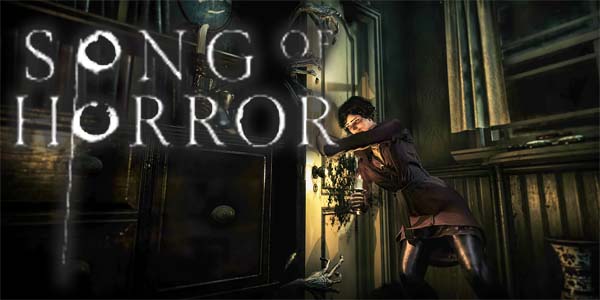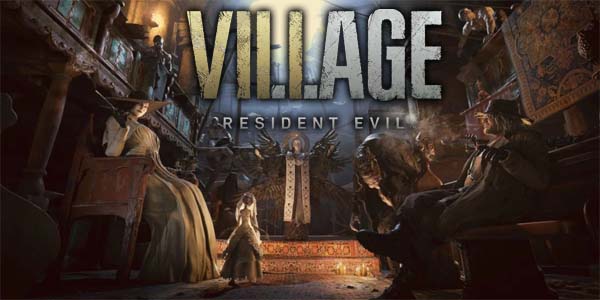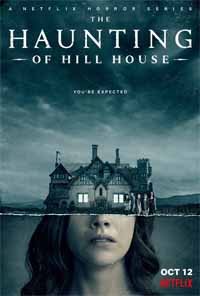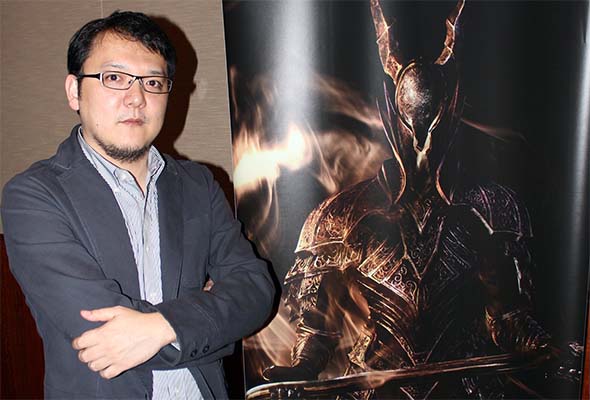
Not only is it really great to play an indie horror game that captures the slow and thoughtful nature of old-school survival horror, but it's also refreshing to play a good old fashioned gothic horror game. So many indie horror games come off as feeling a bit pretentious with their reliance on suppressed guilt twists for their psychological horror plots. Song Of Horror bucks that trend by being a straight-forward horror story about haunted houses, possessed artifacts, and otherworldly mysteries.
Song Of Horror also ups the stakes by featuring a cast of multiple playable characters, each of whom can be killed off (and removed from the rest of the story) if the player screws up. So not only do we literally not know what eldritch abomination may lie around any given dimly-lit corner, or behind any creaky old door, but if you're not careful, whatever is around that corner or behind that door might put a premature end to a given character's life and story.
Strut and fret your hour upon the stage, and then ...
Song Of Horror was originally sold as an episodic indie horror game on Steam, but the collection of all episodes was released for console as a single game in 2021. It somehow slipped under my radar until last month, when YouTube recommended a video about it by Mert Kay Kay. Each episode includes 3 or 4 playable characters to choose from, each of whom can be permanently killed off if you fail to avoid or escape from the phantasms that haunt each episode. If a character dies, all the items and notes that they've collected will be dropped on the floor at the spot of their death, and that location will be marked on the next character's map. So you don't really lose any progress if a single character dies. If you lose all the characters in a given episode, however, then it's "Game Over"!
Each episode will introduce one or more new characters, but old characters can also re-appear as playable characters if they survived the previous episode(s). Thus, losing a character in an early episode may have the longer-term consequence of reducing the player's available lives (to borrow a term from old arcade parlance) for future episodes, and reducing your margin of error.
Each episode has 3 or 4 playable characters, each of whom can permanently die.
But even if you do manage to screw up and get all 4 characters killed in any given chapter, you only have to restart that chapter. Song Of Horror won't delete your save file and force you to redo the entire game. Each chapter takes 2 -- maybe 3 -- hours to complete on a first-playthrough, and can be done in well under an hour if you know what you're doing. It's actually a loss of progress that is somewhat on par with dying in an old Resident Evil game after doing a fair chunk of exploration without backtracking to a save point.
The legitimate threat of permanently losing a character will naturally raise the stakes of the game and of the horror. It will force the player to play cautiously, to be observant of your surrounding and of context clues in the environment, to pay close attention to sounds and shadows, and to not barge through every door in a rush. In fact, it may do this more effectively than even a game like Resident Evil. Dying doesn't mean simply restarting with the same character and retrying the set piece that got you killed. Dying means permanently losing that character, and having to try again with a new character. Restarting at a checkpoint doesn't simply reset the stakes, it doubles-down on them!
Furthermore, the actual jump scares and dangers are semi-randomized. You won't necessarily encounter the same jump scare or the same monster at the same place and time in any 2 playthroughs. This also keeps things tense, because even on a replay (whether it be a whole new playthrough, or just a respawn with a different character), you can't just memorize all the places to avoid.
[More]
0ffa3716-e34f-4cd6-a026-763157eedc54|0|.0
Tags:Song of Horror, Protocol Games, Raiser Games, horror, cosmic horror, gothic horror, H.P. Lovecraft, perma-death, music, sound, light, dark, Silent Hill

Village seems to be positioning itself as a sort of "greatest hits" of earlier Resident Evil games. I'm not sure it all comes together as well as Capcom must have hoped it would. Resident Evil VII Biohazard did an excellent job of modernizing the design philosophies of the original Resident Evil game. Map design, inventory and resource constraints, and the "fight or flight" nature of enemy encounters all perfectly re-captured the feel of the original PS1 classics, without all of the clunkiness.
Village maintains the exploratory map design of the original Resident Evil and of Resident Evil VII, but it also tries to port concepts and aesthetics from the Resident Evil 2 remake and from Resident Evil 4. The RE2 stuff fits well enough, but the RE4 influences just don't feel compatible with classic design philosophy.
The setting instantly reminded me of Resident Evil 4.
Clash of philosophies
Right off the bat, the general aesthetic screams "Resident Evil 4". The game begins in a small, rustic, eastern European village at the foot of a gothic castle. Just like in RE4, you're quickly ambushed by the monstrous villagers and have to desperately fight your way out. Resident Evil 4 replaced the traditional zombies of the series with semi-aware "ganados"; Village similarly breaks away from the traditional zombies, but this time, the monsters are werewolves.
Not long into the game, you'll start smashing crates to reveal hidden loot, and pixel-hunting along the walls and ceilings for obnoxious sparkling gems to shoot down and collect. Also just like in Resident Evil 4, you'll routinely get rewards of items and money from defeated enemies. That money and loot is used to buy items or upgrade your equipment at a shop, just like in Resident Evil 4. This is where the game started to break down for me.
Loot, ammo, and cash can be recovered from smashed crates or defeated enemies.
Giving the player rewards of in-game cash for defeating foes (and for wasting bullets to shoot glowing gems off of walls) completely changes the motivations of the player in how we deal with enemies. I'm no longer carefully considering whether to try to sneak past an enemy or run away, nor am I ever firing off a single round at an enemy's knee to stun or cripple it so I can get away without consuming more resources, the way I might in REmake2. Since every defeated foe returns some of the resources that I invest into killing it, there is no "fight or flight"; only "fight". The enemies stop being threatening or frightening, especially on the standard difficulty setting, in which ammunition is readily available and the monsters patiently await their turns to charge and attack.
Even inventory management is mostly thoughtless. The more linear, more action-oriented, and less puzzle-oriented design of the game means that key items and treasures are not put in your limited inventory, and there isn't even a storage box to keep excess weapons or supplies. Only weapons, ammo, and healing items go into your briefcase. Everything else has unlimited storage. Even crafting components have separate, unlimited storage (the only exception being the animals meats needed for the Duke to cook meals -- more on this later). [More]
b05b0e00-39c0-4ac3-9d47-9089537c0f54|1|5.0
Tags:Resident Evil, Resident Evil VIII Village, Capcom, horror, survival horror, action, shooter, Resident Evil 4, gothic horror, vampire, werewolf, Ethan Winters, Lady Dimitrescu, castle
I'm not a particularly voracious reader of fiction. Most of my reading is in the form of books and magazines about science or history. But I do try to squeeze in a novel here and there -- usually something from the canon of classics. I never write about them on this blog because I doubt I have anything of value to say about them. Besides, being predominantly a video game writer means that I lack the vocabulary for expressing critical opinions of non-interactive media. I struggle to get by with the reviews of movies and TV shows that I write.
However, I read a rather unique novel over the summer that I do feel I can discuss. In large part, my willingness to talk about this particular novel comes from the fact that this particular novel actually has an interactive element to it that makes some of my video game criticism lingua more applicable. The novel in question is House of Leaves by Mark Z. Danielewski, published by Pantheon Books in 2000.
I was introduced to this book by a YouTube video from Noah Caldwell-Gervais about the 2019 Blair Witch game on the XBox. Towards the end of the video, he talks about the conclusion of the Blair Witch game, which involves surreal, looping hallways. He goes on to talk about the recent fad of looping hallways, which has been seen in games ranging from Blair Witch to Layers of Fear to P.T.. He then talks about a novel which may have served as an inspiration for these games, and which attempts to simulate the feeling of being lost in a corridor (and the ensuing madness that it brings on) through the structure and organization of the text itself. This piqued my interest, and I promptly hopped onto Amazon and ordered a copy of the book. I was going to have a lot of downtime during the stay-at-home lockdowns of the COVID-19 pandemic, and needed something to help kill the time.
I was inspired to read House of Leaves after watching Noah Caldwell-Gervais' critique of Blair Witch.
Indeed, I ended up enjoying House of Leaves, which has become a sort of paradigm shift for me in terms of how the written word can engage the reader. For me, House of Leaves is a watershed work of literature, in much the same way that Demon's Souls was a watershed video game. House of Leaves is my first encounter with true "ergodic text" (unless you want to count the "Choose Your Own Adventure" books I read as a child) and has redefined (for me) how a textual work (such as a book) can go about engaging its audience, and how it can tell a story in a more interactive manner than other peers in the respective media.
It's impossible to discuss this book and its merits without going into spoiler territory. As such, there will be some minor or moderate spoilers in this review. I'll try to keep them as light as possible, but consider yourself warned.
Lost in the pages
House of Leaves employs several framing devices to tell multiple narratives simultaneously. At the center is a documentary movie, called The Navidson Record about a family (named the Navidsons) exploring a supernatural house that is bigger on the inside than it is on the outside, and which regularly changes its interior size and geometry in increasingly impossible ways. This movie is being reviewed and researched by a third party named Zampanò, who is writing a book about the documentary in the hopes of determining if the documentary depicts a real supernatural phenomena, or if it is the work of Hollywood trickery. Zampanò dies while working on this book, and his research is recovered by a third party named Johnny Truant, who attempts to piece together Zampanò's research and finish his work. Both Zampanò and Johnny become increasingly obsessed with The Navidson Record, and eventually go mad.
To further obfuscate the work, the introduction establishes that the original version of the work was a series of scattered pages, photographs, video clips, and audio recordings that were passed around on paper, VHS, and cassette tapes before being posted piecemeal to internet message boards in the mid-to-late 90's. The scattered documents were eventually collected by a book publisher and edited together into a single published work, which is implied to be the novel that you are holding in your hand.
Danielewski employs multiple framing devices to tell between 2 and 4 concurrent narratives.
Zampanò transcribed the events of the film into text, along with his own interpretations and commentary. Then Johnny reviewed Zampanò's notes, and added his own interpretations and commentary on top Zampanò's commentaries, while also maintaining a journal of his daily life (and decline in sanity).
[More]
c8d76660-b100-46c7-9774-8b927318f2f9|3|5.0
Tags:House of Leaves, Mark Z. Danielewski, novel, ergodic text, horror, gothic horror, cosmic horror, romance, hallway, abyss, drug addiction, schizophrenia, strategy guide, Noah Caldwell-Gervais, Blair Witch, COVID-19, pandemic

Oh boy, this is going to be a tough one to talk about. I have very mixed, and somewhat polarized views of how this turns out, and as such, I'm struggling with whether or not I can offer a recommendation. The first five or six episodes are fantastic! After that, however, I really feel like the show peters out, begins to meander and run in place, and then kind of unravels in the end. Those first five or six episodes are so good, however, that I think I can recommend the series as a whole based on the strengths of its first half.
I can't discuss this show without getting into spoilers, so be warned that the further down you read, the more spoiler-y this will become.
A masterfully suspenseful start
Each of the first five or six episodes is told from the point of view of a different sibling in a family that is tormented by a summer spent in a haunted house. This structure creates a deeply textured and nuanced tapestry, in which each episodes recasts the events of the previous episodes in a new light. Giving each character his or her own episode provides us with a rich character study that helps us to understand each character's attitude when they all get together and the family drama gets rolling. All the while, the subtle supernatural elements create a building sense of intrigue as the mysteries surrounding Hill House, and the family's last night there, continue to mount and the plot continues to thicken.
Each of the first six episodes is told from the perspective of a different character.
I really love the camera work! Slow pans and zooms are used with excellent effect to draw out scenes and add tension and keep the scene mysterious. Sometimes, there's a creepy detail in the background. Other times, there's an ominous lack of anything creepy to see as the camera slowly pans from character to character across a room or down a hallway. In any genre other than horror, these labored camera movements would seem wasteful and pointless, but they really add to the atmosphere here.
The set design is also really great. The gothic Hill House provides an excellent and ominous set piece, but the other sets are also uncanny and unnerving in their own right, especially Shirley's funeral home. Around episode 6 or 7, I was really starting to struggle with reconciling the geometry of Hill House, and this is something that is paid off really well at the end of the series.
The geometry of Hill House becomes a source of unease as the series develops.
A meandering, incoherent ending
Unfortunately, the series faltered a bit for me after the sixth episode. At this point, all the characters are together in one place, and so no one character receives the focus of the narrative. The story starts to meander a bit here, while also running in place, as the intrigue that was so carefully crafted in the preceding episodes is squandered, new plot points and concepts are thrown at the audience, and old plot points and concepts just disappear.
... [More]
Now that Dark Souls is supposedly over (pending the inevitable DLC for Dark Souls III), it's time to wonder what new games From Software and Hidetaka Miyazaki might decide to make. Will they continue to make Souls-like games (ala Bloodborne)? Will they go back to older IPs like Armored Core or King's Field? All indications seem to point towards the company going back towards making mech games along the lines of Armored Core (though it may be a new IP).
I've played some of the Armored Core games, and I actually really liked some of the PS1 / PS2 - era games. But I would actually much rather see the company try their hand at something different. I'd like to see this company (under Miyazaki's direction) take a stab at a genuine horror game.

Miyazaki has said that Dark Souls is likely over. So what's next for his company?
They've already played around with some horror concepts in some of the Souls games. Levels like the Tower of Latria and Valley of Defilement in Demon's Souls had genuinely frightening atmospheres. The Dark Souls games also had their share of some horror-inspired levels. Sen's Fotress and Tomb of the Giants have the pacing of a horror level. And of course, Bloodborne was a whole game inspired by Gothic horror and Lovecraft.
Granted, these games were all hack-and-slash action games, rather than genuine horror games, but ... [More]
dc7859e5-750b-4d0a-8b97-ea244ddeecd1|1|5.0
Tags:Hidetaka Miyazaki, From Software, Armored Core, Dark Souls, Demon's Souls, Bloodborne, Tower of Latria, Valley of Defilement, Sen's Fortress, Tomb of the Giants, horror, medieval, fantasy, gothic horror, H.P. Lovecraft, environmental story-telling, world-building
|

| 12 | | | | | | | 60 | | 11 | | | | | | | 55 | | 10 | | | | | | | 50 | | 09 | | | | | | | 45 | | 08 | | | | | | | 40 | | 07 | | | | | | | 35 | | 06 | | | | | | | 30 | | 05 | | | | | | | 25 | | 04 | | | | | | | 20 | | 03 | | | | | | | 15 | | 02 | | | | | | | 10 | | 01 | | | | | | | 05 |
|